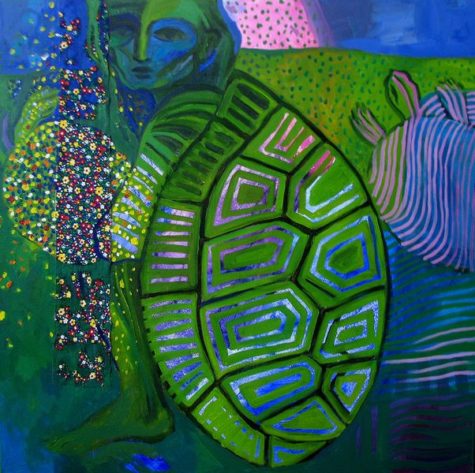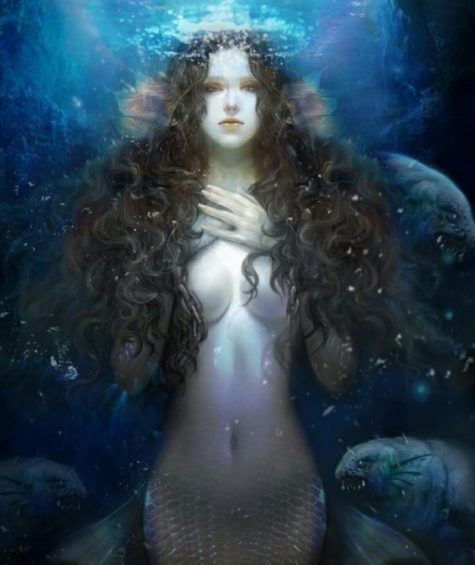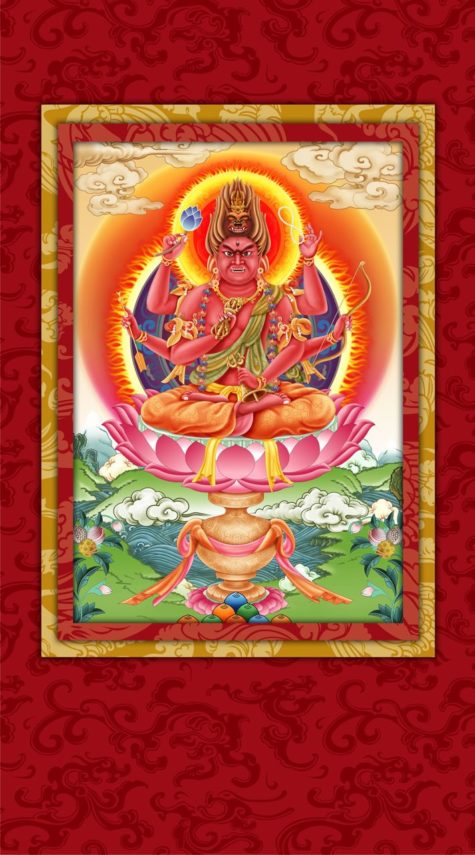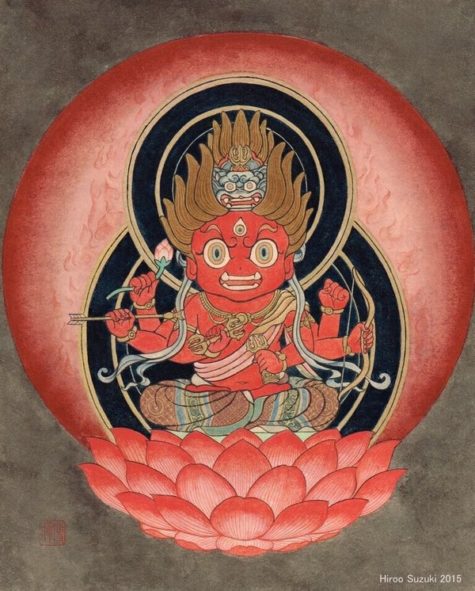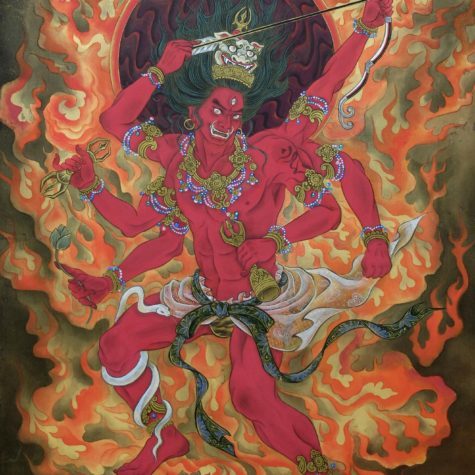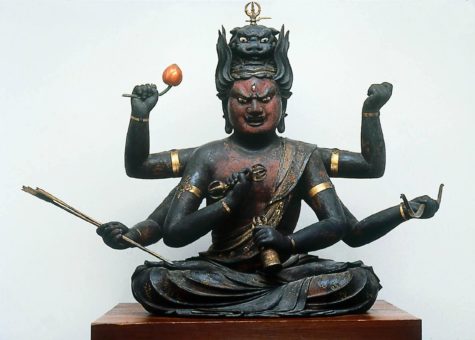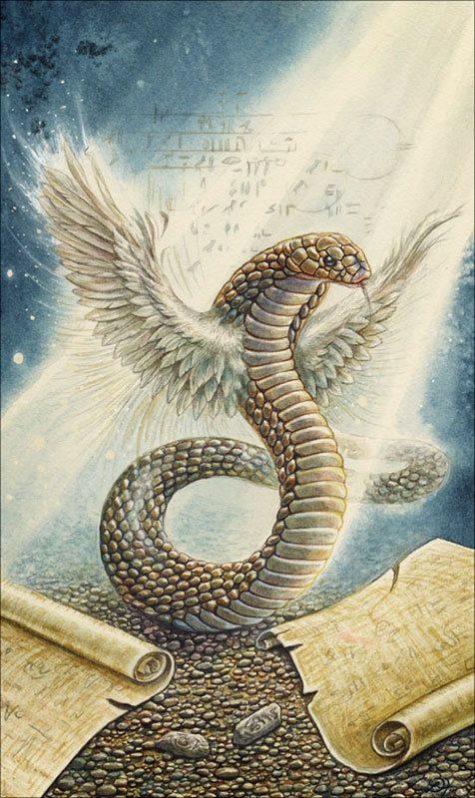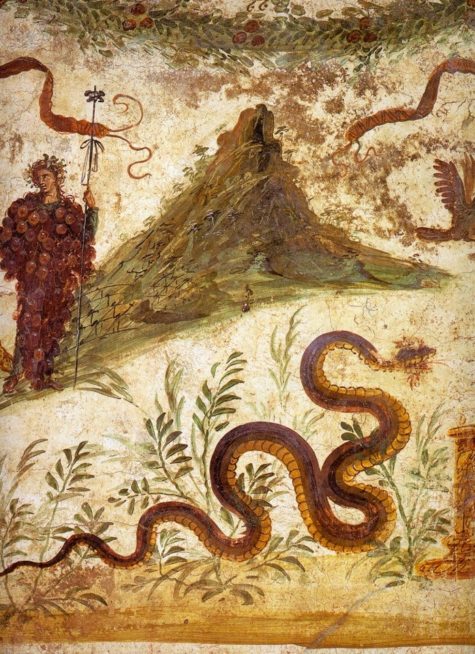Yearly Archives: 2018
- Origin: Greece
- Also known as: Khelone
- Animal: Turtle, Tortoise
- Flower: Turtlehead flowers (Chelone species)
- Symbol: Silence
Chelone is said testudo (tortoise) in Latin. “Khelônê” means “tortoise” in Greek. The tortoise was a symbol of silence in ancient times.
Chelone, an Oread nymph (mountain nymph) of Arcadia in Greek mythology. She objected to the nuptials of Hera and Zeus. Some accounts say that she was jealous of Zeus’ marriage to another nymph, other stories contend that she was late and then decided not to go, claiming she never received her invitation.
The stories vary as to how it happened, however, Zeus was angered by her absence, and as a result she was transformed into a tortoise, condemning her to eternal silence. Because of this, Chelone is the spirit of silence. She may be invoked by those who need silence as well as by those who have been silenced. Chelone is the matron of political prisoners, those persecuted for voicing objections as well as those afraid to speak their minds.
Chelone is also the matron of the homeless and those able to carry all their possessions on their backs.
Variations of the story are as follows:
Certain parts of the myth tell that Chelone was taking too long to be ready for the feast, which caused Zeus to become enraged. In retribution, he crashed her house over her, and thus condemned her to drag her house forever as a tortoise.
- Zeus turned her into a sea turtle and banished her to the ocean, with all her belongings strapped to her shell.
- Hermes, who hosted the event and extended the invitations, felt this to be a personal affront and changed her into a tortoise so now she can never leave home for any event.
- Because she would not leave her home, Zeus caused her house to collapse on top of her. Now she carries it wherever she goes.
- Hermes descended from Olympus, threw Chelone’s house, which stood on the bank of a river, together with the nymph, into the water, and changed her into a turtle, who had henceforth to carry her house on her back.
In some stories and fables, the Gods are referred to as their Roman equivalents: Jupiter (Zeus), Juno (Hera), and Mercury (Hermes).
Collected from various sources.
- Alternative names : JURATA, JŪRATĖ, JURASMAT
- Location : Lithuania, Latvia and Prussia
- Gender : Female
We connect with the Goddess Jurate to promote feelings of courage and unforeseen love. Her sway of the sea flows directing into our afflictions, washing away the fear and doubt, and rolling in the acceptance of the journey of love. There are times in life when we feel we do not have the strength or motivation to pursue the completion of our set goals of compassion and love. We must follow through, with pride and determination for the journey ahead.
We must never be driven away from our path, by unsettling feelings of fear or self-doubt. We should embrace the adventure of love, for it is a roller coaster that is the act of life personified.
Lithuanian Myth of Lost Love
A famous folktale favorite across the Baltic and beyond, Jurate is Queen of the Lithuanian mermaids — a rare and unusual mythological species. She is also a deity of healing who fell in love with a mortal called Kastysis.
At the deepest point of the Baltic Sea, a beautiful, goddess (sometimes described as a mermaid or undine) Jurate lived in a beautiful and unusually fascinating castle made completely from the shiny golden amber. While on the shores of the Baltic Sea (in Šventoji town to the north of Palanga), not far from the castle of the goddess, a young and handsome fisherman named Kastitys lived in the poor shack and earned for living with fishing.
Jurate ruled the sea and all of the sea-life. Each and every sea creature was not simply the subject to her, but a true lovely friend. Jurate knew that people were killing them for survival and although it destroyed her from the inside, there was nothing that could be done. A lot of people were dealing in the sea, relying on and surviving only due Jurate’s kindness, but one of them was known for being extremely active. A young fisherman named Kastitys was continuously disturbing the peace in her kingdom by catching daring amounts of fish. One day, Kastitys had not succeeded in his usual area and swam too near the castle of the beautiful goddess, despite the existing restrictions that his people respected for centuries.
The anger of Jurate knew no boundaries. This reckless fisherman must be stopped. Jurate sent mermaids to the fisherman with a warning stay away from her castle and to stop killing her fish friends. But this had no effect. Kastitys was desperate and daring – he ignored the warnings of the mermaids.
Even though she was angry, Jurate became extremely curious about this simple mortal who was not even slightly afraid of the anger of the gods. She decided that she wanted to see this person who was so fearless, and so she swam to the surface of the sea.
When Jurate saw the beautiful Kastitys, and heard the glorious songs he sang to entertain himself while fishing, she was completely won over, and fell desperately in love. Listening with delight to the songs, Jurate quite forgot that immortal gods were not allowed to enjoy fleeting human happiness. She completely forgot about everything that had once been important to her.
Jurate took Kastitys to her beautiful amber castle, and they spent days and nights enjoying each others company and their love, totally losing track of time. Unfortunately, their happiness didn’t last.
Perkunas, Baltic god of thunder, rain, mountains, oak trees and the sky was furious when he learned that the goddess had allowed herself a terrible liberty. To be involved in relationship with a mere mortal was unforgivable. Perkunas, was in love with Jurate. However Jurate did not return the feeling and was not interested in the thunder god in any way. She had rejected and spurned his love many times. Not only had she fallen in love with another man, but she had fallen in love with a mortal man!
He sent a bolt of lightning to destroy the goddess’ palace and kill her mortal lover. According to eyewitness reports, the amber palace was smashed into little bits and Kastysis smashed with it. Her healing efforts were in vain and he died.
Perkunas chained Jurate with gold chains to the ruins of the underwater palace. That was the high price that she had to pay for her short happiness.
She weeps tears of amber for her lost lover. When the storms stir the sea, fragments of her palace ruins are driven onto the shores of the Baltic. Tear drop shaped pieces are thought to be particular treasures as they are the tears washed from the grieving goddess’ eyes. These amber pieces are said to be as clear and true as her tragic love.
Years and centuries pass, but the immortal Goddess is still suffering. Day by day, looking at the lifeless body of her beloved, enmeshed in heavy golden chains, she is shedding bitter tears. The cold sea depths are beginning to sway from her inconsolable sobbing. A storm is rising. The storming sea is rolling its waves towards the shore throwing onto the sand splinters of the amber castle and small hardened drops – Jurate’s tears.
Jurate put everything on the line being with Kastytis, and lost, but she would do it again in a heartbeat because love is the only catalyst to pure happiness, that cannot be replicated or changed into anything else.
Embracing our deep connection to the goddess Jurate can help us find the bravery to take the ultimate risk to be in love. She is not commonly known as a goddess of love, but her story compares to that of no other. To honor her love, and incite feelings of bravery, utilization of an Amber crystal is best. Carry her legacy with you to inspire yourself to go against any odds in life to find your love.
Her strength is a type of bravery that often goes unnoticed; the willingness and courage to change your life into one of completely new templates. When you are in love, you suddenly feel that you can and will do anything and everything for that one special person. You put your entire life in their hands, and forget the vulnerability and openness of entrusting another human being with the baggage that is you. Commitment is often difficult, because sometimes you start off with nothing to lose, and end up losing everything. You put all your apples in one basket that you lose sight of the path in which the basket will travel; if it will be clear, or riddled with obstacles.
Love is a path often untraveled by man, as the journey is difficult and sometimes confusing. We must embrace our inner light of love and divinity. Embrace your goddess today, and promote love to everyone around you. Feel the love inside of you, and spread it to others.
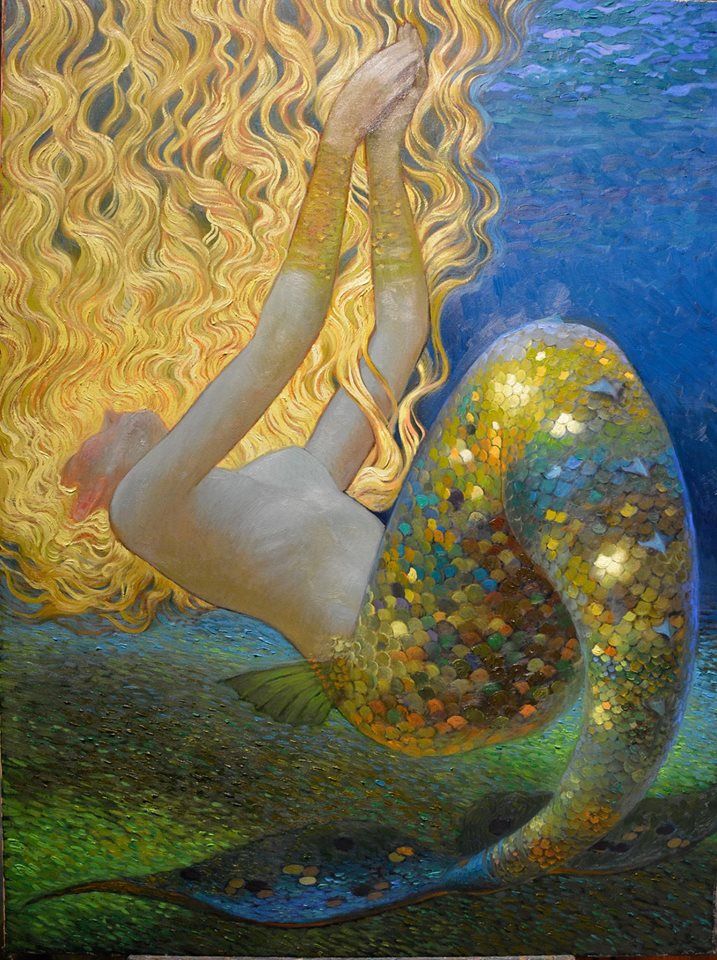
Beautiful Amberella may have legs or a mermaid’s tail. She wears an amber crown and is bedecked with amber jewelry.
Although amber is the product of trees, because it was often found tossed up by waves, it was associated with the sea. Amber is the vehicle with which to communicate with Amberella. She is a completely benevolent spirit and may be requested to assist with love (especially forbidden love), fertility, pregnancy, and relief from poverty.
An Amberella Altar
Amber is considered magickally beneficial during pregnancy. Place amber jewelry on an altar dedicated to Amberella, requesting her blessings before you wear it. Decorate her altar with sea treasures such as shells, sea glass, and small stones, as well as images of mermaids and sea creatures.
Lithuanian Myth of Amberella
The beautiful maiden Amberella lived on the shores of the sea with her fisherman father and his wife. While swimming, Amberella is drawn into a whirlpool and pulled into the depths of the sea. Amberella finds that she has been captured by the Prince of the Seas to serve as his princess.
He keeps her as his wife in a fabulous undersea palace of amber. When Amberella begs to be returned to her parents, the prince is enraged. He mounts white foaming horses, grasps his princess in his arms, and rises to the surface in a furious storm.
As the Prince of the Seas and Amberella rise from the water, her parents see her in his grasp. She is adorned with an amber crown and amber necklace. In her hands she holds lumps of amber which she tosses to her grieving parents. As the prince and Amberella sink back into the sea, they realize their daughter is lost forever.
Now, when the Prince of Seas becomes angry, the seas begins to churn and storms rage. From her prison-palace below, Amberella tosses pieces of amber onto the shores to show her parents how much she misses and loves them.
Source: The Encyclopedia of Spirits
Aizen-Myōō, also known as Rāgarāja, is one of the five Wisdom Kings. Other titles and names include the following:
- Lord of Passion
- King of Lust
- Lust-Drenched One
- Impassioned One
- King of Sexual Passion
Ragaraja, Buddhist Lord of Passion, traveled from India to Japan, where he transformed into Aizen Myo’o, venerated by Japan’s esoteric Buddhist sects as King of Love, Lust, and Desire, patron of erotic love and sacred sexuality. He helps convert earthly, physical desires into transcendent love and spiritual awakening.
He is portrayed as a red-skinned man with a fearsome appearance, a vertical third eye and flaming wild hair that represents rage, lust and passion. Also the Lustful-Tinted Wisdom King was popular among Chinese tradesmen who worked in the fabric-dying craft, typically accomplished with sorghum.
He is still venerated as a patron of landlords, prostitutes, homosexuals and petitioned by devotees for a peaceful home and abundant fortune in business. There is usually a lion’s head on top of his head in his hair, representing the mouth into which thoughts and wishes may be fed. Some of these are the wishes of local devotees who make formal requests for success in marriage and sexual relations.
Aizen Myo’o is King of Lust because he helps control it, explore it, or transform it into enlightenment. He is petitioned for assistance with the physical and emotional frustrations of suppressed sexuality. Aizen Myo’o is revered as patron of gay love, but he may be invoked for assistance with any kind of love or romance, including self love.
Aizen converts earthly desires (love/lust) into spiritual awakening, and saves people from the pain that comes with love. Aizen is celebrated in Japanese rites to achieve harmony and friendship, to succeed in one’s romantic endeavors, to gain the love and respect of others, and to reach a clear understanding of the Dharma (Buddhist law).
- Favored People:
Aizen Myo’o guards prostitutes and sex workers. He is venerated by those for whom sex is a business, including sex shop owners and those working with any form of pornography or erotica. He is also venerated by singers, musicians and landlords.
He is the patron deity of dyers, possibly because the second part of his name means “dye” or “to dye” (hence “soaked”).
Today, Aizen is revered in Japan’s gay quarters as the patron of love. Aizen does not appear in Indian texts, and is unknown among India’s deities.
- Iconography
Aizen is usually depicted with a red body possessing eight arms and three eyes on an angry face. A lion’s head rests in his hair, symbolizing passion. He carries bows and arrows, which symbolize love as well as his role as a destroyer of evil. Aizen’s red body symbolizes the power to purify sexual desire. He is typically bright red, suggesting the force of the passions, yet, at the same time, the vigor of his compassion.
He is portrayed as a red-skinned, frowning man, his appearance representing suppressed lust and passion. He variously has two, four or six arms; in the latter form, his hands bear a bell, a stick, a thunderbolt, a lotus, a bow and an arrow. Similarly, he sometimes has two heads, with a lion’s head in his wild hair.
His lion headdress indicates that Aizen possesses the strength of the five wisdom Buddhas. His three eyes are able to see the “three realms” of desire, form, and non-form.
His mouth is usually half-opened and reveals fangs. His hair is fiery and stands on end. Aizen is often surrounded by flames, which indicate the burning power of the passions. Aizen is usually seated on a lotus throne and carries a lotus flower in one of his four arms.
The most distinctive feature of Aizen is his bow and arrow, which is the best way to identify him (though it is sometimes missing). Interestingly, experts on Buddhist iconography are not agreed about the precise meaning of the bow and arrow.
All agree that it is a weapon against evil. Furthermore, according to some, it chases away carelessness and neglect (in observing Buddhist precepts).
For others, the arrow is Aizen’s love (somewhat like Cupid’s arrow), and, in another theory, it is the conquering strength of wisdom. Sometimes, Aizen holds a small mirror, a symbol of the void in Buddhism. He typically appears with six arms, but sometimes with only four.
The blood-red body and flaming halo of Aizen Myōō, the Wisdom King of Passion, represents the state at which sexual excitement or agitation becomes enlightenment and passionate love becomes compassion for all living things. In Buddhism, he manifests as a vajrasattva.
Aizen Myōō is the embodiment of rage: his hair stands on end, a snarling lion rises from his head, and his six arms brandish Esoteric Buddhist weapons and other emblems of power. The bow and arrow in his middle hands are attributes appropriated from Kama, the Hindu god of love.
Though fearsome in appearance, this wisdom king acts only out of love for others. In Japan, Aizen is thought to control the amorous passions, redirecting them to ward the struggle to overcome desires.
In contrast to this righteous anger, jewels of good fortune forming flaming clusters spill from a vase in front of the deity’s lotus throne. While Aizen Myōō’s appearance may instill fear, the faithful afflicted with problems of the heart address him as a popular intercessor.
The Rāgarāja Mantra
Appropriately, Rāgarāja’s mantras are pronounced in either Chinese or Japanese transliterations of Sanskrit; the cadences depending upon the respective region where his devotees reside and practice, and whether in the Shingon or Tendai schools. His seed vowel, as written in bonji, is pronounced “HUM,” usually with a forceful emphasis coming from the use of lower belly muscles.
To invoke Ragaraja, one needs to form his mudra and chant his mantra. While holding the mudra, rub the middle fingers against each other – this represents ”love to connect.” By invoking him in this way, Ragaraja will come quickly and descend into your body.
Here’s a video:
For the sake of the men and women in emotional distress, sentient beings engaged in love and passion, and couples who are separated and need to patch up their relationships, here is the Sadhana of the Ragaraja Affection Practice:
The practitioner must first enshrine the image of Ragaraja. The practitioner may purchase an image, or find an artist to paint an image of Ragaraja, or get a sculptor of Buddhist statues to carve one.
- The Offering
Find the stamen from a red lotus and remove 108 strands from it as an offering. Also make offerings of other foods with a mix of the five tastes: sweet, bitter, sour, salty and hot.
- Preliminaries
Perform the Fourfold Refuge, the Great Homage, the Great Mandala Offering, and the Four Immeasurables.
- The Mudra
Form the Root Mudra of Ragaraja: The two hands have fingers crossed and inwardly clasped like a vajra fist, except for the middle fingers which stand erect and crossed over each other. Form the mudra first before entering into the visualization.
- Visualization
Visualize Ragaraja descending from the light of the sun. Visualize flames surrounding the body of Ragaraja. Visualize your loved ones appearing within the flames. Visualize the arrow of Ragaraja shooting towards the hearts of the loved ones.
- The Mantra
Recite the mantra of Ragaraja: OM MAHARAGA VAJROSNISA VAJRASATTVA JAH HUM BAN HOH. Recite this mantra 108 times, or 1080 times, counting the recitation with your mala beads.
- The Meditation
Sit in meditation and enter into samadhi. The practitioner visualizes himself entering into the heart of Ragaraja together with his loved ones.
Once he comes out of his meditative absorption, the practitioner dedicates the merits and asks that Ragaraja keep his vows to bring fulfilment to the desired love and relationship.
- Concluding the Practice
After performing the Great Homage, take the 108 strands of the red lotus stamen combined with sandalwood incense powder and burn the mixture before the statue of Ragaraja. When you cultivate this practice, a miracle may happen after only a day.
Some individuals may request a sculptor to carve a small statue of Ragaraja out of white sandalwood, about the length of one`s finger. You may enshrine the statue in your shrine, and bring it along with you when you leave the house.When you practice doing this, you shall find fulfillment in all things, especially earning respect from people.
Important Points
I hope everyone who practices this method will benefit from it. However, remember that this practice is meant for those who are sincere and honest, and will not work for people with ulterior motives.
- If a female who is flirtatious and married desires another male, this practice will never work.
- If a male who craves the opposite sex desires another lady when he already is married, this practice will never work.
- If a prostitute with ill intentions desires to catch a rich man, this practice will never work.
- If a male whose heart is fickle and whose actions are topsy-turvy, speaks of love but actually desires sex, this practice will never work.
Here is a verse:
Supreme as Ragaraja himself,
Whose merits and vows are kept firmly in his heart,
When you are sincere and your love is strong as gold and rock,
Pray to him and receive his pure light
Which quickly transforms a relationship to one of affection.
As the self-nature is dissolved into the realm of affectionate beings,
All hindrances shall be eliminated,
Closing the gap between those truly in love
Other Mantra Practices
Ragaraja is a great and mighty deity of love and respect. If relations between a couple are not harmonious, if one wants to acquire great love and admiration from male and female friends, if one wishes to become president or an artist, if one wishes to have a great affinity with all people, if one wishes the presence of valuable people, if practitioners need companions for success on the path of cultivation or need help from someone, if one needs the help of others in one’s studies, if farmers need workers to work for them, and if businessmen need nonstop benefits, they should all practice Ragaraja.
- Assisting in Attaining Spiritual Union with the Principal Deity Dharma
While practicing Vajrayana Buddhism, even after you recite mantras and practice many dharmas, you may still not have any spiritual response from any deity. By reciting Ragaraja’s mantra 300,000 times one will quickly achieve spiritual response.
Ragaraja has great dhama power. One can readily receive spiritual union with one’s personal deity while praying to him for it. Therefore, everyone should chant the deity’s mantra, because he belongs to ”love to connect.”
One will rapidly achieve spiritual union if one practices one’s personal deity after having recited Ragaraja’s mantra for 300,000 times! This is because he is ”love to connect,” which means to ”get you connected.”
- Dharma for Annihilation of Evil
Paint or draw Ragaraja’s image then hang the image on the west wall so that Ragaraja’s image faces east. Then, after completing 300,000 recitations of the Ragaraja mantra, you can perform the ”Shooting with Ragaraja’s Bow and Arrow Dharma.”
Facing to the front, visualize the person you consider to be your enemy in front of you and yourself holding a bow in one hand and an arrow in the other. Then shoot the arrow at the visualized person. The person will no longer go against you.
A second method is as follows. One chooses the afternoon of a ”Chu” (”Removal”) day to practice the dharma. Standing in front of Ragaraja’s image face to the east and form a gesture as if shooting an arrow while you recite the Ragaraja Mantra 108 times. Then, visualizing your enemy in front of you, shoot the arrow at him. Your enemy will immediately retreat.
- Dharma of Drawing an Image
Vajrayana Buddhism highly regards painting a Buddha’s image. While you are painting the Buddha’s image, your entire mind is so focused that you will paint continuously. Because of this attentiveness, the divine nature of Ragaraja will enter the painting you have drawn, and the painting will already be powerful when you hang it up.
When practicing Image Drawing Dharma, one will obtain spiritual union quickly and easily because after drawing Ragaraja’s image for so long, Ragaraja is imprinted in one’s mind.
- Dharma of Love and Respect
Homa for love and respect must be performed between the 16th and 30th days of the lunar calendar. Set up the fire offering mandala in the form of a lotus shaped semi-circle. All offerings, such as flowers, fruits, food, drinks, clothing or other items must be red in color. Throw 180 red lotus stamens into the homa fire burner to be burned. When reciting the mantra, chant ”hum tsa-zhi-hum re” Command ‘name of the person’ and ‘name of the person’ to love and respect each other.”
Please remember, this is to be practiced by one who is honest and sincere. It is not meant to be practiced by ”one who has evil intentions.”
- Nectar Dharma
Ragaraja sits on top of a nectar vase. A lotus stems grows out of this nectar vase becoming a thousand petaled lotus. Visualize that Ragaraja transforms on top of this thousand-petaled lotus, Rajaraja is transformed from the syllable ”hum” The lotus is transformed from the syllable ”bang.” The nectar vase is transformed from the syllable ”seh.” Visualize Ragaraja moving to the top of your head. Ragaraja’s nectar vase is dripping nectar which enters your central channel. Visualize your whole body filled with nectar that eliminates all your bad karma.
You can visualize the amrita as red because Ragaraja is red in color. At this time, your whole body is filled with red amrita and you are purified. This way, you can easily go to Buddha’s Pure Land.
- Carved Image Dharma
Have someone carve an image of Ragaraja about the height of your right thumb. Ragaraja’s height, width, and length should be exactly the same size as your thumb. Because you desire Ragaraja to be fully engraved in your heart, when you have completed 300,000 mantra recitations, Ragaraja will then have a spiritual union with you. Wherever you go, everyone will respect you and all their love will be reflected on your body.
One should practice Carved Image Dharma to protect oneself from being harmed by witchcraft, black magic spells, or evil practices. What one needs to do is to carve the image of Ragaraja and wear it as a pendant in front of one’s chest.
While wearing the carved image of Ragaraja, if you fall in love with a person and wish for Ragaraja to help reciprocate love from this person, all you need to do is recite the Ragaraja Mantra 7 times, and say the person’s name. Alternatively, say ”command ‘names of the person’ and ‘name of the person’ shall love each other.”
Also, after completing 300,000 recitations of Ragaraja Mantra, carry the carved image of Ragaraja with you. Recite the mantra 7 times while on the plane; 7 times while on the boat; 7 times while on the train; or 7 times while in the car. Whichever transportation you take, or if you are walking, or anywhere you may be, recite 7 times; you will not encounter any disasters or calamities.
- Dharma of Exorcising Demons
When helping a mentally ill patient or a person possessed by evil spirits, visualize yourself transforming into Vajrasattva. Then visualize that the syllable ”hum” on the palms of both hands transform into Ragaraja. On top of your head, the ”hum” syllable transforms into Ragaraja; on your face, the ”hum” syllable transforms into Ragaraja. Transform your ”Vajrasattva” body into ”Ragaraja’s” body. Pat the back of the mentally ill patient or person that has been possessed by evil. Or recite ”hum tsa-zhi-hum re” and pat the patient’s back with both your palms. The evil spirit possessing the body will then naturally leave.
- Dharma of Detoxification (Dharma of Purification)
All you have to do is recite the Ragaraja mantra 300,000 times. Then, for any food that you eat, first recite ”hum tsa-zhi-hum re” 7 times. After eating this food, even if it was spoiled or contaminated, the food will become fresh and clean again. When you go home, you will not have diarrhea.
Someone may put a curse on you with black magic, or put a curse on your food, or lace your food with sedatives or other mind-altering drugs. All you need to do is face toward the soda or food and recite ‘ ”hum tsa-zhi-hum re ‘ 7 times and the drugs or sedatives will no longer be effective. Anything that is contaminated will lose its effectiveness and be purified. Anything that is bad will become normal. Anything that has been poisoned will be detoxified.
Therefore, if one falls under spells of black magic or is harmed by witchcraft such as that practiced in Sichuan, Yunnan, Guangxi, and Xiangxi, the witchcraft and the black magic spells can be undone as long as one practices this dharma.
Even if you find yourself in hell and see poisonous snakes, just recite ”hum tsa-zhi-hum re” 7 times and the poisonous snakes will leave. If you are in the hell of swallowing red hot molten metal balls, all you need to do is recite the Ragaraja Mantra 7 times ”hum tsa-zhi-hum re” and the metal balls will turn into moon cake. When you are in the hell of filthy excrement recite ”hum tsa-zhi-hum re” 7 times and all the feces will turn into sausage. Any bad thing will transform into something good.
Information collected from a variety of sources.
- Title: The Good Spirit
- Other Names: Agathodemon, Agatho Daimon
- Origin: Egypt
- Preferred offering: Wine
- Manifestations: Consistently serpentine, he may appear as an ordinary snake or a hovering winged serpent.
Agathodaemon is a benevolent spirit of healing, protection, luck, and good fortune who manifests as a snake. Veneration of Agathodaemon traveled from Egypt to Greece and Italy. He is a consistently benevolent spirit. In Egypt, he evolved into a Gnostic guardian angel.
Agathodaemon is a companionable spirit. Among the deities with whom he happily shares altar space are Serapis, Tyche, and Hermes. He may be fond of Sicily’s Saint Agatha who may or may not be an ancient serpent-goddess in disguise.
Agathodaemon survives in modern Egypt, too, albeit undercover. Each of Cairo’s four quarters allegedly possesses its own snake-shaped guardian spirit, its own Agathodaemon.
The Greek version of this deity, is known by Agathos, or Agatho Daemon. Information on this version of the Serpent Spirit can be found here: Agathos.
Source: Encyclopedia of Spirits
- Also known as: Agatho Daemon
The Romans and Hellenistic Greeks did not like deities in the shapes of animals. They liked their spirits to resemble humans. Adopted Egyptian spirits thus adapted in form.
Agathos may be Agatho Daemon in human form; he may be an emanation of Agatho Daemon who developed into an independent spiritual entity; or he may always have been a distinct spirit.
Agathos is Lord of Vineyards and watches over fields of grain, peace, prosperity, and plenty. He bestows wisdom, good health, and good luck. Agathos was venerated at home, traditionally by a family together.
The worship of the Agatho Daimon was and is mostly a private practice. Greek families poured out a few drops of wine to him after every meal. Small offerings were sometimes left out to the daimon, which appeared as a snake around the household.
To honor the spirit, pour out libations to him, speak to him on a regular basis, asking for protection for yourself and your home. You might also make a sculpture of a snake to serve as a visual reminder of your daimon.
He shows his favor via a family’s good fortune (or lack thereof). Agathos guarantees that a family has sufficient food and drink.
- Favored people: Barkeeps, those who own vineyards or grow artisanal grain.
- Manifestations: Agathos manifests as a snake or a handsome young man.
- Attributes: Goblet, ear of wheat, poppies, cornucopia, staff or wand entwined by a snake.
- Offerings: Toast Agathos with a glass of wine at each meal; if you’re not drinking, then just set one aside for him.
The second day of every Athenian month was also a sacred day, devoted to the Agathos Daimon (good spirit). The name “daimon” does not mean the evil demon of modern Christianity, (although it did have a negative form, called the kakodaimon), but was thought to be an aspect of Zeus, as Zeus Ktesios, Charitodotes, and Epikarpios, titles as giver of increase and joy.
Agathos Daimon is most often represented in the form of a snake, a symbol of healing. However the daimon is also a function of one’s being, a characteristic inherently neither good nor bad. Hence, one prays for a good daimon, an eudaimon, and goodness from the gods for the coming month and also for the favor of father Zeus as Agathos Daimon.
Pindar, Socrates, Proclus and Plotinus mention their daemons as well. The spirit acts as a guardian against error and a guide in life.
Burkert (Greek Religion, p. 181) says that “One must be on good terms with it.” And Pindar sang that “The daimon active about me I will always consciously put to rights with me by cultivating him according to my means” (Pyth. 3.108f) and “The great mind of Zeus steers the daimon of the men whom he loves” (Pyth. 5.122f). The philosopher Sokratēs talks of his own daimon as a small voice which speaks to him and warns him to refrain from certain actions (Plato, Apology, 31d).
The myth of the Agatho Daemon can neither be proved nor disproved. “Agatho” stems from the Greek “to agathon,” meaning the highest or supreme good in a moral sense, summum bonum. Since the daemon brought both spiritual and material wealth to a household or person, the Agatho Daemon amounts to the “good spirit.”
Each person was assigned a daemon at birth, and the “good spirit” of the daemon protected and guided him through life. Sacrifices of milk and honey were made to the daemon on one’s birthday. Otherwise a cup of consecrated or spiritually pure wine was passed around at dinner, called the cup of the Agatho Daemon. As we shall see, these rituals were meant as an affirmation of life (and thus as an acknowledgement of death).
The Agatho Daemon was the “good” half of a good and evil duality. This duality was portrayed in frescoes as a serpent with the head of a lion with 7 or 12 solar rays emanating from it. The serpent portion was called the kakodaemon, representing the underworld and water, and the lion’s head was the Agatho Daemon, representing the solar fires.
The cosmic interpretation of the daemon as solar provider was tied to the household’s prosperity in the form of the genius. The lion-headed serpent was frequently pictured along with the household genius, the latter shown as a youth holding a horn of plenty and a bowl, or a poppy and ears of corn, representing the growth and abundance of harvest. The harvest imagery along with the serpent as rain and sun were all symbolic of a successful harvest.
Information about the Egyptian version of this deity, known as Agathodaemon, can be found here: Agathodaemon.
Information collected from various sources
